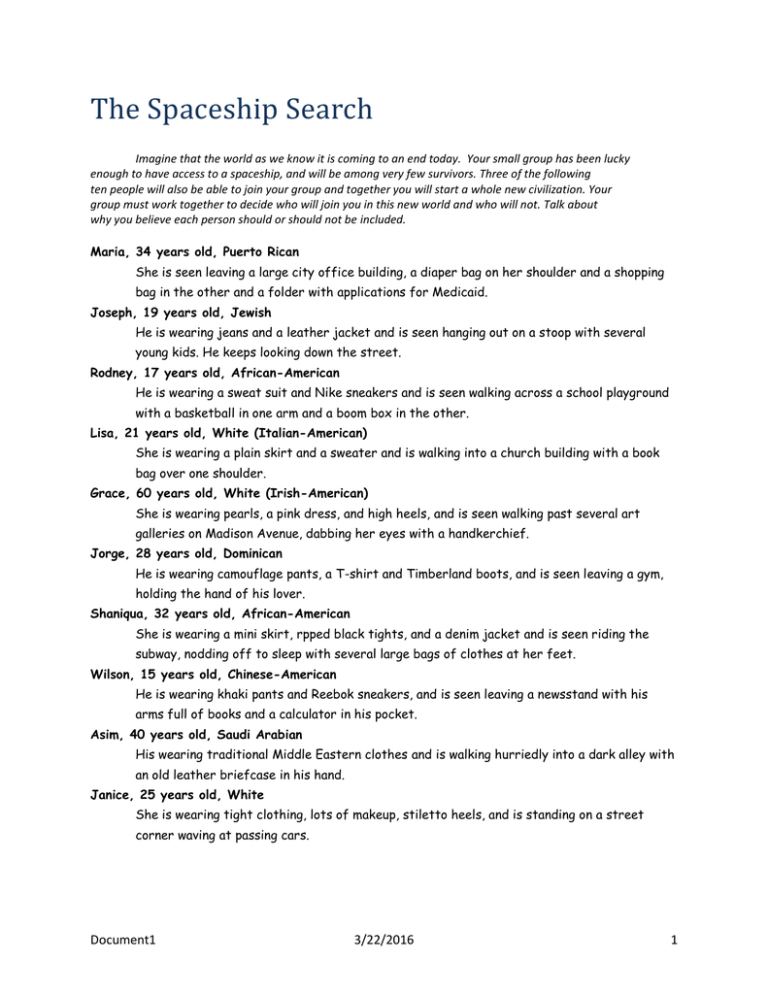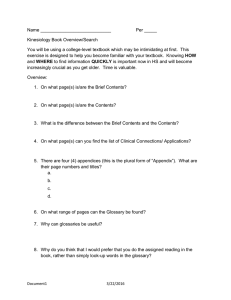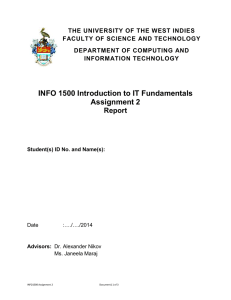Lecture 2 - Porterville College
advertisement

The Spaceship Search Imagine that the world as we know it is coming to an end today. Your small group has been lucky enough to have access to a spaceship, and will be among very few survivors. Three of the following ten people will also be able to join your group and together you will start a whole new civilization. Your group must work together to decide who will join you in this new world and who will not. Talk about why you believe each person should or should not be included. Maria, 34 years old, Puerto Rican She is seen leaving a large city office building, a diaper bag on her shoulder and a shopping bag in the other and a folder with applications for Medicaid. Joseph, 19 years old, Jewish He is wearing jeans and a leather jacket and is seen hanging out on a stoop with several young kids. He keeps looking down the street. Rodney, 17 years old, African-American He is wearing a sweat suit and Nike sneakers and is seen walking across a school playground with a basketball in one arm and a boom box in the other. Lisa, 21 years old, White (Italian-American) She is wearing a plain skirt and a sweater and is walking into a church building with a book bag over one shoulder. Grace, 60 years old, White (Irish-American) She is wearing pearls, a pink dress, and high heels, and is seen walking past several art galleries on Madison Avenue, dabbing her eyes with a handkerchief. Jorge, 28 years old, Dominican He is wearing camouflage pants, a T-shirt and Timberland boots, and is seen leaving a gym, holding the hand of his lover. Shaniqua, 32 years old, African-American She is wearing a mini skirt, rpped black tights, and a denim jacket and is seen riding the subway, nodding off to sleep with several large bags of clothes at her feet. Wilson, 15 years old, Chinese-American He is wearing khaki pants and Reebok sneakers, and is seen leaving a newsstand with his arms full of books and a calculator in his pocket. Asim, 40 years old, Saudi Arabian His wearing traditional Middle Eastern clothes and is walking hurriedly into a dark alley with an old leather briefcase in his hand. Janice, 25 years old, White She is wearing tight clothing, lots of makeup, stiletto heels, and is standing on a street corner waving at passing cars. Document1 3/22/2016 1 Culture: Chapter 2 I. Culture: _________________ patterns of ________________ a. _______________________ b. _______________________ c. _______________________ d. Shared: ___________________, ___________________, ideas, doctrine e. Culture __________________________ health f. Cultural _____________________________ g. Heterogeneous: Consists of ___________________ ethnic groups II. Terms to know a. __________________: _________________ held by a culture b. __________________: Deep ___________________ that determine what is considered _____________ or ____________ c. __________________: Society accepted ______________ d. __________________: ____________________ customs e. __________________:_______________ policies enforces by _______________ f. __________________: strong ______________ beliefs g. __________________:Social remedies for __________________ any norms h. __________________: Language, gestures or objects used to _________________ i. __________________: Similar ____________________ characteristics j. __________________:Shared cultural _______________________ k. __________________: Belief that your _______________ is __________ than another l. III. __________________:______________, overgeneralized belief about a group Transcultural Nursing a. Cultural ___________________________ b. Cultural ___________________________ c. Cultural ___________________________ IV. 6 Cultural Characteristics a. _______________________________ b. _______________________________ Document1 3/22/2016 2 c. ______________ orientation d. _______________________________ e. __________________ control f. V. ________________________ variations Religious Care Considerations a. Islam: i. ____________________, washing, privacy ii. Caregivers of the same _______________________ iii. Food: Do not eat _____________________ iv. Fasting: _____________________ b. Judaism i. Sabbath: _______________________ ii. Food: ______________________, do not eat ____________________ c. Hinduism i. Food: ___________________________ do not eat _____________________ d. Catholic: i. No ________________ on Fridays ii. Icons: iii. Anointing for ____________________ and _________________ e. The Church of Jesus Christ of Latter-day Saints/ Mormon i. Food: Do not eat_________________________ ii. Wear special ________________________ f. Methodist/ Lutherans i. Anointing g. Assemblies of God i. Pray & Laying on of ___________________ for healing h. Jehovah’s Witness i. NO _________________ transfusions ii. Do not _________________________ holidays i. 7th day Adventist i. Food: Do not eat: _________________, ___________________, ________________ Document1 3/22/2016 3 ii. Sabbath: _________________________ j. Christian Science: i. Do not ___________________ traditional medical treatment ii. Avoid ____________________________ Directed Reading 1. What are cultural competence, awareness and sensitivity? 2. What do the terms culture, race, and ethnicity mean? 3. Define transcultural nursing. 4. Who introduces the theory of transcultural nursing? 5. What is the fastest growing ethnic group in the USA? 6. That is the largest cultural group in the USA? 7. Which cultural group believes good health is a gift from the ancestors? 8. Define religion? 9. What are common cultural barriers to health care? 10. Identify the common disease affecting the major ethnic groups of the USA (Hispanic, Native, African, European, Asian and Arab American). Document1 3/22/2016 4 origin Document1 3/22/2016 Biological variation control Environmental Social organization Time orientation Space Communication Nation of Asian African Europe American Indian Hispanic 5 Cultural Awareness Self-Assessment Form Please give a qualitative evaluation of each of the ten factors by circling the number that represents the appropriate numerical score which in your judgment best represents your assessment of your performance on each factor. This is not an opportunity to assess your desires, wishes, hopes, dreams, or even your potential. 7 = outstanding (superb); 6 = excellent; 5 = very good; 4 = average (good); 3 = fair; 2 = poor; 1 = very minimal; 0 = no ability at all. 1. I listen to people from other cultures when they tell me how my culture affects them. 1 2 3 4 5 6 7 2. I realize that people from other cultures have fresh ideas and different points of view to bring to my life and to the workplace. 1 2 3 4 5 6 7 6 7 4. I give people my support even when other members of my culture reject them. 1 2 3 4 5 6 7 3. I give people from other cultures advice on how to succeed in my culture. 1 2 3 4 5 5. I realize that people outside of my culture could be offended by my behavior. I’ve asked people if I have offended them by things I have done or said and have apologized whenever necessary. 1 2 3 4 5 6 7 6. I realize that when I am stressed out I am likely to make myself and my culture right and another culture wrong. 1 2 3 4 5 6 7 7. I respect my superiors (boss, teacher, supervisor, group leader, etc) regardless of where he or she is from. I do not go over his or her head to talk to someone from my culture in order to try and get my way. 1 2 3 4 5 6 7 8. When I am in mixed company, I mix with everyone. I do not just stay with people from my culture, or only with people from the dominant culture. 1 Document1 2 3 3/22/2016 4 5 6 7 6 9. I go out of my way to work with, recruit, select, train, and/or promote people from outside the dominant culture. 1 2 3 4 5 6 7 10. When people in my culture make jokes about or talk negatively about other cultural groups, I let them know that I don’t like it. 1 2 3 4 5 6 7 Total all of your scores together (for a maximum of 70 points) 61 – 70 You have an outstanding (superb) cultural awareness. Further growth will only increase your incredibly strong awareness base and make you even more culturally aware than you are. 51 – 60 You have excellent cultural awareness. There is room for growth, and the areas you have designated that are less than six or seven are areas you can target for specific growth and development. With the foundation you already have, it is clear the motivation and interest in further growth and development are clearly established; thus, it should be relatively easy for you to focus and concentrate on those areas that need additional attention. 41 – 50 You have very good cultural awareness, but it is clear from your responses that there are a number of areas that you can target for additional growth and development. Look back at the survey to see if you can see a pattern in your responses-that is, areas that can be grouped together. If not, then simply target the areas that are indicated on the survey for greater experience and possible growth, change, and development. Less than 40: Your level of cultural awareness is average, below average, weak, or poor, but you have a wonderful opportunity to grow, develop, and change. This score may reveal a lack of opportunity for you to meet and interact with people from other cultures. There are numerous opportunities in college for you to expand your cultural awareness, and you need to begin a program for healthy interaction with people from other cultures at once. There is no time to lose, and the college experience, along with a course in speech communication, as well as courses that introduce you to other cultures, should provide you with a host of opportunities to improve your cultural awareness. Document1 3/22/2016 7 Project 1: Assessing your cultural awareness Value: 25 points Due Date: September 18, 2013 @ 12:45 PM Assignment: 1. Participate in the classroom activity “The Spaceship Search” 2. Complete the Cultural awareness self-assessment form 3. Type a 300 – 600 word paper / essay or thought piece addressing the following questions: a. Describe the group dynamics with the spaceship search? b. What did you learn about yourself by doing Spaceship search exercise? c. Were you surprised by the choices others made in the spaceship search? d. How did you score on the cultural awareness assessment? e. What are your low areas in the assessment? What are your high (or strongest) areas on the assessment f. What did you learn about yourself by completing this assessment? Did it make you more aware of areas you can improve in? g. Why do nurses need to be culturally aware? 4. Submit your essay to turnitin.com by 12:45 PM on the due date (by the start of class). Grading Rubric Criteria 300 – 600 words Submitted to turnitin.com Timely Correct grammar, spelling & punctuation Addresses the topic Original work Completeness and Depth of response Document1 0 points 5 points Not submitted on 6-14 grammar errors time or Or 15+ grammar Less than 300 words errors or Doesn’t address the questions 0 points Not submitted Or Only gives the results of test 5 points Does not address all of the questions or does not cover 3 -4 questions completely 3/22/2016 10 points All objective met 0-5 grammar errors 10 points Does not cover 1 – 2 questions completely 15 points Gives results of assessment & covers each question completely 8









